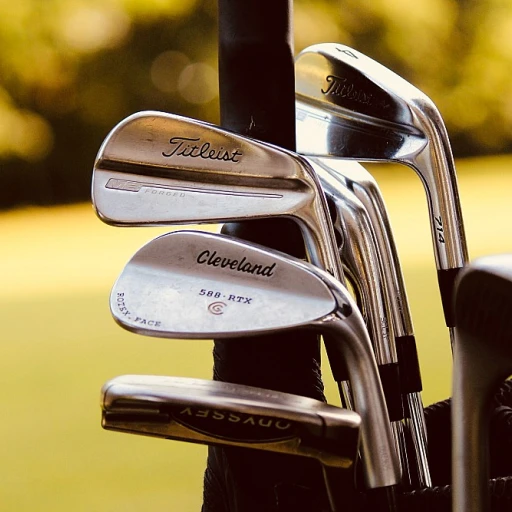
The Phenomenal Year of Tiger Woods
The Unforgettable Season of 2000
The year 2000 was nothing short of extraordinary for Tiger Woods, marking a period of dominance that would forever change the landscape of professional golf. Woods' performance during this time was a masterclass in skill, precision, and mental fortitude. His achievements were not just about winning; they were about redefining what was possible on the golf course.
In this remarkable year, Woods won nine PGA Tour events, including three major championships: the U.S. Open, The Open Championship, and the PGA Championship. His victory at the U.S. Open at Pebble Beach was particularly memorable, where he won by a staggering 15 strokes, a record that still stands today. This performance was a testament to his unparalleled ability to dominate the field, leaving his competitors in awe.
Woods' success was not just about the number of tournaments he won, but the manner in which he did so. His ability to maintain composure under pressure, execute precise shots, and strategize each round with meticulous detail set a new standard for excellence in the sport. The Associated Press named him Sportsman of the Year, recognizing his influence and impact on the game.
As Woods continued to break records and set new benchmarks, his influence extended beyond the golf course. His dominance in 2000 played a significant role in elevating the status of golf as a luxury lifestyle, inspiring a new generation of players and enthusiasts. The ripple effects of his success can be seen in the evolution of luxury golf products, from equipment to apparel, and even in the design of golf courses themselves.
For those interested in exploring the impact of Tiger Woods' legendary year on the luxury golf scene, the Rocket Mortgage Classic 2024 offers a comprehensive guide to one of the premier events in the sport today.
Influence on Luxury Golf Equipment
{"The Tiger Effect on High-End Golf Equipment
":"\n\nWhen we reflect on the impact Tiger had on golf, his influence on luxury equipment innovation stands out. Tiger definitively raised the bar when it came to the standards of precision and performance, especially during that phenomenal year when he set the world abuzz by triumphing in major championship after major championship. As professional golf bore witness to these feats, manufacturers felt the urge to cater to the newfound demand for high-caliber equipment capable of enhancing a player’s ability to replicate such excellence.\n\nFollowing the 2000 season, numerous brands harnessed advanced technology to develop clubs and balls that offered greater control, enhanced accuracy, and impressive distance. Consequently, they invested significantly in research and development, employing materials typically reserved for the aerospace industry, such as titanium and carbon fiber composites, to produce clubs aimed at helping players shave strokes off their game.\n\n- \n
- \nOne noticeable trend sparked by Tiger’s success was the evolution of drivers. With enormous clubheads becoming a norm, players enjoyed wider sweet spots and increased forgiveness. Think of the revolutionary impact that the larger titanium drivers had on improving a golfer’s shot, especially during a high-stakes championship situation.\n \n
- \nPutters, too, experienced a design metamorphosis, offering players enhanced precision on the greens. The newfound belief was that expert engineering trusted by Woods would help replicate those crucial, championship-winning putts.\n \n
- \nEven golf balls, a seemingly small part of the kit, underwent a transformation. Multilayered designs aimed at mimicking Tiger's ideal trajectory by providing a combination of length with optimal spin control.\n \n
The Evolution of Golf Apparel
The Transformation of Golf Fashion
The year 2000 marked a pivotal moment not just in the world of golf but also in the realm of golf apparel. As Tiger Woods dominated the PGA Tour, his influence extended beyond the greens, reshaping how players approached their attire. The surprising stature of Tiger Woods in the sport brought a fresh perspective to golf fashion, blending performance with style.
During this transformative period, golf apparel began to prioritize functionality without compromising on elegance. The demand for high-performance fabrics that could withstand the rigors of a championship round while maintaining a sophisticated look became paramount. This shift was not just about aesthetics; it was about enhancing the player's experience on the course.
Several key trends emerged:
- Technical Fabrics: The introduction of moisture-wicking materials and breathable textiles allowed players to maintain comfort throughout the tournament, regardless of the weather conditions.
- Tailored Fit: Gone were the days of baggy polos and ill-fitting trousers. The modern golfer embraced a more tailored silhouette, reflecting a professional and polished image.
- Color and Patterns: While traditional colors remained popular, bold patterns and vibrant hues began to make their way onto the course, offering players a chance to express individuality.
This evolution in golf apparel was not just a fleeting trend but a lasting change that continues to influence the sport today. As we look to the future, the integration of technology in clothing, such as smart fabrics and enhanced durability, will likely play a significant role in shaping luxury golf products.
Impact on Golf Course Design
Redefining the Greens: A New Era in Course Design
The year 2000 marked a pivotal moment in golf history, not just for the phenomenal achievements of Tiger Woods, but also for the transformative impact on golf course design. As Woods dominated the PGA Tour, winning major championships with remarkable shot precision and strategic prowess, golf course architects began to rethink their designs to challenge the new breed of players.
Woods' ability to conquer courses like Pebble Beach and the Masters Tournament with ease led to a reevaluation of course difficulty. Designers started incorporating longer fairways, more strategic bunkering, and complex greens to test even the most skilled players. This evolution was not just about adding length; it was about creating a more engaging and challenging experience for both professionals and amateurs.
Moreover, the influence of Woods' dominance extended beyond the physical aspects of the courses. The rise of golf as a luxury lifestyle meant that courses needed to offer more than just a game; they had to provide an experience. This led to the integration of luxury amenities, such as high-end clubhouses, fine dining, and exclusive membership benefits, elevating the status of golf courses worldwide.
As we look to the future, the trends set in motion by Woods' era continue to shape the landscape of golf. The demand for courses that cater to both the competitive spirit and the luxurious lifestyle of players is ever-growing, ensuring that golf remains a sport of prestige and elegance.
The Rise of Golf as a Luxury Lifestyle
The Emergence of Golf as a Premium Lifestyle Choice
The awe-inspiring performances and accomplishments on the golf course have significantly shaped the perception of golf as a luxurious lifestyle. The year of dominant performances has not only created legends but also provided a plethora of opportunities for redefining golf as a premium experience.- Association with Success: Consistently exceptional performances have linked golf with success, excellence, and luxury. This association has drawn in an audience eager to experience the opulence of the sport, beyond just the game itself.
- Exclusive Tour Events: Participation in prestigious tour events has become a hallmark of luxury, with players and spectators alike desiring to partake in the fascinating environment and camaraderie.
- VIP Experience at Major Championships: The major championships have transformed into exclusive gatherings where affluent individuals come to witness elite performances, further solidifying the sport's luxurious allure.
- Rise in Demand for High-End Golf Resorts: Luxury golf resorts have emerged as sanctuaries for aficionados worldwide, offering an amalgamation of world-class facilities, gourmet dining, and exquisite accommodation.
Future Trends in Luxury Golf Products
Anticipating the Next Wave of Luxury Golf Innovations
As we look towards the future of luxury golf products, the influence of Tiger Woods' remarkable year in 2000 continues to resonate. The evolution of golf equipment and apparel has been significantly shaped by his dominance, and this legacy is expected to drive future innovations in the industry.
One area poised for growth is the integration of technology in golf equipment. The use of advanced materials and smart technology is becoming more prevalent, offering players enhanced performance and precision. Expect to see clubs that provide real-time data analytics, helping golfers refine their swing and improve their game.
Luxury golf apparel is also set to evolve, with a focus on sustainability and high-performance fabrics. As players seek comfort and style on the course, brands are responding with eco-friendly materials that do not compromise on quality or aesthetics.
Moreover, the design of golf courses is likely to reflect a blend of tradition and innovation, inspired by the courses where Woods made history. Courses may incorporate elements that challenge players while offering a luxurious experience, catering to the growing demand for golf as a lifestyle choice.
Finally, the rise of golf as a luxury lifestyle suggests that exclusive memberships and bespoke experiences will become more common. These offerings will cater to those who view golf not just as a sport, but as an integral part of their lifestyle, much like the way Woods' career has elevated the game's prestige.
In summary, the future of luxury golf products is bright, with innovations that promise to enhance the game while honoring the legacy of past champions. As the industry evolves, it will continue to attract enthusiasts who appreciate the blend of tradition, technology, and luxury.

















